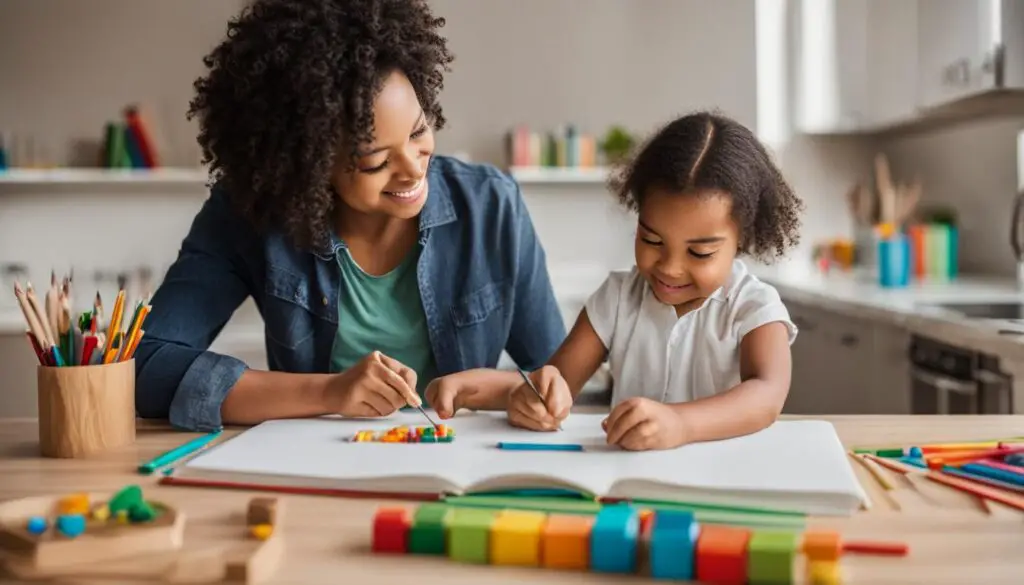
Understanding Your Child’s Learning Style for Better Education
Welcome to an insightful exploration of understanding your child’s learning style and how it can positively impact their education. As a parent, I understand the importance of providing the best possible educational experience for our children. By uncovering their unique learning style and implementing effective strategies, we can empower them to excel academically and foster a love for learning.
Research has shown that every child has a preferred way of absorbing and processing information. By identifying and catering to their learning style, we can create an environment that maximizes their potential and facilitates better learning outcomes. Together, let us explore the different learning styles, how to identify them, and practical strategies to support our children’s individual needs.
Key Takeaways:
- Understanding your child’s learning style can enhance their educational experience
- Identify the different learning styles: visual, auditory, kinesthetic, and tactile
- Implement effective strategies that support your child’s learning style
- Create a learning environment that nurtures your child’s individuality
- Collaborate with teachers and educators to support your child’s unique learning style
The Benefits of Understanding Your Child’s Learning Style
Understanding your child’s learning style can have numerous benefits in enhancing their educational experience. By recognizing and adapting to their unique learning needs, you can provide customized support and resources that foster their development and success.
One of the key advantages of understanding your child’s learning style is the ability to tailor your teaching methods to match their individual preferences. By doing so, you can optimize their comprehension, engagement, and overall academic performance. When the teaching approach aligns with their learning style, it creates a more effective and efficient learning experience.
A deeper understanding of your child’s learning style also enables you to create a positive learning environment that nurtures their abilities. When you cater to their specific needs, you can help them thrive and build confidence in their own learning capabilities. This, in turn, fosters a lifelong love for learning and encourages them to explore their potential to the fullest.
“By recognizing and adapting to their unique learning needs, you can provide customized support and resources that foster their development and success.”
Additionally, understanding your child’s learning style allows you to provide targeted support to address their learning challenges. By identifying their strengths and weaknesses, you can tailor your approach to help them overcome obstacles and make progress in areas where they may struggle. This focused support can significantly boost their learning outcomes and build a solid foundation for their future academic achievements.
Lastly, understanding your child’s learning style can strengthen the parent-child relationship by promoting effective communication and understanding. When you are aware of their preferred learning methods, you can engage in meaningful conversations about their education, support their learning journey, and facilitate a productive collaboration with their teachers and educators.
Benefits of Understanding Your Child’s Learning Style
| Benefit | Description |
|---|---|
| Optimized teaching approach | Adapting teaching methods based on the child’s learning style enhances comprehension, engagement, and academic performance. |
| Positive learning environment | Catering to the child’s learning style creates a supportive atmosphere that fosters confidence and love for learning. |
| Targeted support | Understanding learning challenges enables tailored support to overcome obstacles and promote progress. |
| Strengthened parent-child relationship | Effective communication and collaboration with teachers contribute to a supportive educational ecosystem. |
Different Learning Styles and How to Identify Them
Understanding the different learning styles of your child is crucial for their educational development. By identifying their unique learning style, you can tailor their learning experiences to optimize their understanding and engagement. There are four main types of learning styles: visual, auditory, kinesthetic, and tactile.
Visual learners prefer using images, graphs, and visual aids to comprehend information. They benefit from seeing information in a visual format, such as charts or diagrams. To identify if your child is a visual learner, observe their inclination towards visual materials and their ability to remember images.
Auditory learners, on the other hand, absorb information best through listening and speaking. They learn effectively through verbal explanations, discussions, and storytelling. If your child is an auditory learner, they may show a preference for listening to instructions rather than reading them.
Kinesthetic learners thrive on hands-on activities and movement. They learn best through physical experiences and are often energetic and active. To identify if your child is a kinesthetic learner, observe their need for hands-on activities and their tendency to use gestures or actions while learning.
Tactile learners prefer touching and manipulating objects to understand and retain information. They learn through physical touch and enjoy hands-on experiences. If your child demonstrates a preference for using their sense of touch and often reaches out to feel objects, they might be a tactile learner.
To identify your child’s learning style, closely observe how they naturally engage with information and tasks. Pay attention to their preferences, strengths, and areas where they may struggle. Look for patterns in their learning behavior and adapt your teaching methods accordingly.
By understanding and identifying your child’s learning style, you can cater to their individual needs and provide them with a personalized learning experience. This will ultimately enhance their comprehension, engagement, and overall academic performance.

Coming up next, we will explore effective strategies for supporting your child’s learning style and creating a nurturing learning environment.
Strategies for Supporting Your Child’s Learning Style
Once you understand your child’s learning style, you can implement effective strategies to support their education. By tailoring your approach to match their preferred style, you can enhance their learning experience and maximize their potential. Here are some strategies to consider:
Visual Learners:
Visual learners thrive on visual cues and images. To support their learning style:
- Provide visual aids, such as diagrams and charts to help them visualize concepts
- Use color-coded notes to emphasize important information
- Encourage them to create mind maps or visual representations of their ideas
Auditory Learners:
Auditory learners absorb information best through listening and speaking. To support their learning style:
- Engage in discussions and debates to encourage active participation
- Tell stories or provide verbal explanations to help them understand complex topics
- Encourage them to read aloud or listen to audiobooks for better comprehension
Kinesthetic Learners:
Kinesthetic learners thrive on hands-on activities and physical movement. To support their learning style:
- Incorporate hands-on experiments and interactive activities into their lessons
- Encourage them to use manipulatives or props to understand abstract concepts
- Allow them to take breaks for physical activity to help them stay engaged
Tactile Learners:
Tactile learners prefer touching and manipulating objects to understand information. To support their learning style:
- Provide sensory materials, such as textured objects or tactile learning tools
- Encourage them to engage in hands-on experiences and project-based learning
- Allow them to take notes or draw diagrams to reinforce their understanding
Remember, it’s essential to incorporate a variety of teaching methods that align with your child’s learning style. This approach ensures that they stay engaged, motivated, and can fully grasp the concepts being taught.

Creating a Learning Environment that Nurtures Individuality
When it comes to your child’s education, creating a learning environment that embraces and nurtures their individuality is crucial. By acknowledging their unique needs and preferences, you can provide the support and resources they need to thrive.
Offering a Variety of Resources
One way to nurture individuality is by providing a diverse range of resources and materials that cater to different learning styles. For visual learners, incorporate visual aids, charts, and graphs into their learning materials. Auditory learners can benefit from recordings, discussions, and audio books. Kinesthetic learners thrive when given hands-on activities and opportunities for movement, while tactile learners appreciate the use of textured materials. Remember to tailor the materials to your child’s specific learning style to maximize their engagement and comprehension.
Allowing Flexibility
Flexibility is key in creating a supportive learning environment. Give your child the freedom to choose how they complete assignments or study subjects of interest. For instance, if they excel in creative writing, allow them to write a story instead of taking a traditional multiple-choice test. This flexibility honors their individuality and empowers them to take ownership of their learning journey.
Encouraging Independent Thinking
Promote independent thinking and problem-solving skills by encouraging your child to explore different perspectives, think critically, and come up with their own solutions. Encourage them to ask questions, challenge assumptions, and pursue their own interests. By fostering an environment that values independent thinking, you help your child develop a strong sense of self and cultivate a lifelong love for learning.
Celebrating Achievements and Providing Constructive Feedback
Recognize and celebrate your child’s achievements to boost their confidence and motivation. Whether it’s an academic accomplishment, improvement in a particular subject, or a personal milestone, make sure to acknowledge their efforts and hard work. Additionally, provide constructive feedback that helps them grow and improve. Offer specific praise for their strengths and provide guidance for areas that need development. This balanced approach fosters a positive learning environment that supports your child’s individuality.
Creating a learning environment that nurtures individuality is essential for your child’s educational journey. By providing a variety of resources, offering flexibility, encouraging independent thinking, and celebrating their achievements, you can support their unique learning style and create a foundation for lifelong learning.
Collaboration with Teachers and Educators
Collaborating with your child’s teachers and educators is a crucial step in understanding and supporting their unique learning style. By working together, you can create a cohesive and tailored approach to education that maximizes your child’s potential. Effective collaboration lays the foundation for a strong partnership between home and school, ensuring your child’s academic success and holistic development.
Sharing Information and Insights
One of the first steps in collaborating with teachers and educators is to share valuable information about your child’s preferred learning style, strengths, and challenges. Understanding their individual needs will enable educators to design lesson plans and activities to suit their learning style, enhancing their comprehension and engagement. By sharing insights about your child’s learning style, you empower teachers to create an inclusive classroom environment.
“Collaboration between parents and educators is essential for a child’s education. By sharing valuable insights about the child’s learning style, parents help educators create a vibrant and inclusive classroom that caters to each student’s needs and abilities.”
Seeking Feedback and Adaptation
Teachers and educators have a wealth of experience in adapting their teaching methods to accommodate diverse learning styles. Regularly seeking feedback and guidance from them allows you to understand how classroom activities and assignments can be adjusted to meet the needs of your child’s learning style. This collaborative approach ensures a supportive and inclusive learning environment where your child can thrive.
Open Communication and Partnership
Open communication is the key to a successful collaboration with teachers and educators. Stay engaged with your child’s education by attending parent-teacher conferences, volunteering in the classroom, or joining parent-teacher associations. Actively participate in discussions about your child’s progress and seek recommendations for additional resources or strategies to support their learning at home.
Remember, collaboration with teachers and educators is a two-way street. Share your observations and insights from home with the educators involved in your child’s education. Building a strong partnership based on mutual trust and respect will benefit your child’s educational journey and create a nurturing and supportive learning environment.
| Benefits of Collaboration with Teachers and Educators | Strategies for Effective Collaboration |
|---|---|
|
|
Conclusion
Understanding your child’s learning style is crucial for their educational success. By acknowledging their individual needs and preferences, you can tailor their learning experiences to optimize their comprehension and engagement.
In this article, we have discussed the benefits of understanding your child’s learning style, as well as different learning styles and how to identify them. Armed with this knowledge, you can implement effective strategies that support and enhance your child’s education.
Collaboration with teachers and educators is essential in creating a cohesive approach to your child’s learning style. By sharing information and seeking feedback, you can work together to adapt classroom activities and assignments to meet your child’s needs.
Create a nurturing learning environment that celebrates your child’s individuality. Offer resources and materials that cater to different learning styles, encourage independent thinking, and provide constructive feedback. By doing so, you can foster a lifelong love for learning in your child.
FAQ
What is the Education Track program?
The Education Track program is an initiative by projectHandUp’s Gatehouse Grapevine that provides resources and support for single mom college students. It addresses housing, childcare, financial planning, and more, allowing single moms to focus on their education without working full time.
Why is understanding my child’s learning style important?
Understanding your child’s learning style is important because it allows you to provide customized support and resources that cater to their specific needs. This can improve their comprehension, engagement, and overall academic performance.
How can I identify my child’s learning style?
To identify your child’s learning style, observe how they naturally engage with information and tasks. Pay attention to their preferences, strengths, and areas where they struggle. This will help you determine if they are visual, auditory, kinesthetic, or tactile learners.
What strategies can I use to support my child’s learning style?
The strategies for supporting your child’s learning style depend on their specific style. For visual learners, provide visual aids and diagrams. For auditory learners, engage in discussions and storytelling. For kinesthetic learners, incorporate hands-on activities and movement. For tactile learners, offer sensory materials and hands-on experiences.
How can I create a learning environment that nurtures my child’s individuality?
You can create a learning environment that nurtures your child’s individuality by providing a variety of resources and materials that cater to different learning styles. Offer flexibility in how your child completes assignments or studies, encourage independent thinking and problem-solving skills, and celebrate their achievements.
Why is collaboration with teachers and educators important?
Collaboration with teachers and educators is crucial because they play a key role in understanding and supporting your child’s learning style. By sharing information about your child’s preferred learning style, strengths, and challenges, you can work together to adapt classroom activities and assignments to meet your child’s needs.
How can understanding my child’s learning style benefit their education?
Understanding your child’s learning style can greatly enhance their educational experience and academic success. By recognizing and catering to their individual needs, you can improve their comprehension, engagement, and overall performance in school.
How can I support my child’s unique learning style?
To support your child’s unique learning style, utilize the strategies discussed in this article that align with their style. Additionally, collaborate with teachers and educators, create a nurturing learning environment, and provide resources and materials that cater to their specific needs.